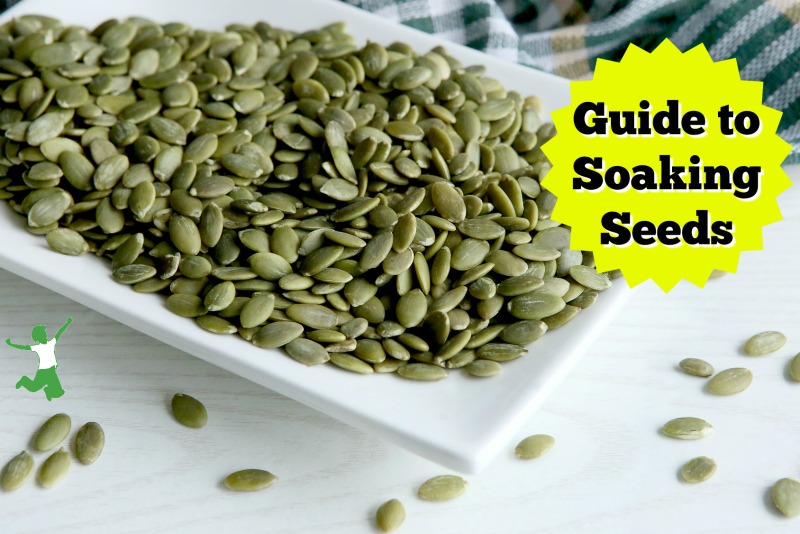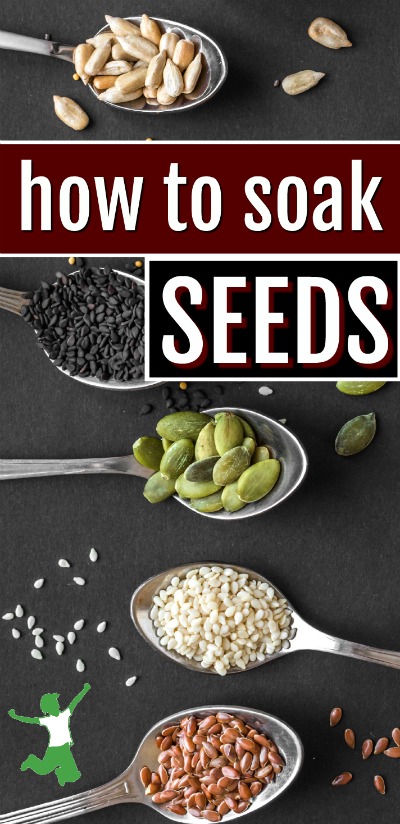
Raw seeds are an excellent addition to a whole food diet. To fully benefit from the nutritional benefits, however, soaking seeds before eating is a wise practice. The process is similar to the method for raw soaked nuts.
This mimics the preparation methods of healthy ancestral societies.
For example, seeds were a staple food of the Aztec culture. Preparation involved soaking the seeds in brine water and then drying them out in the sun. They consumed the seeds whole or ground into meal for baking after the drying process was complete. (1)
Why Soak Seeds?
Soaking seeds in salted water performs the function of increasing digestibility tremendously. Anti-nutrients such as phytic acid are neutralized, which allows increased absorption of minerals and overall improved nutritional value. (2, 3)
In fact, if raw seeds are not soaked before eating, the phytic acid will actually block mineral absorption! Soaking nuts in salted water requires a similar process to unlock maximum nutritional benefits.
The wise practices of traditional cultures teach us that the proper preparation of a food is as important as the food itself.
The mineral zinc is especially vulnerable to blockage by phytic acid in seeds. (4)
Many people are deficient in this critical nutrient even though they are getting adequate amounts in their diet. If you eat a lot of unsoaked seeds, try this home test for zinc deficiency to assess your levels.
You might be surprised to learn that you are not absorbing minerals from raw seeds adequately.
Soaking Maintains Rawness
Some may question the wisdom of soaking seeds because eating seeds raw preserves enzymes.
However, soaking seeds does not in any way impact rawness. Enzymes are 100% preserved when care is taken to follow a low temperature drying process.
You can either use a dehydrator or a warm oven to accomplish this goal. The process for using a food dehydrator is described in the linked article.
I prefer to use a warm oven to dry out my soaked seeds. This is because I tend to soak large batches at a time, and an oven is more convenient to get the drying done all at once.
My oven has a “Warm/Proof” setting that keeps the temperature below 150 °F/ 65 °C, which is the temperature necessary to maintain rawness and preserve enzymes.
Do All Seeds Need to Be Soaked?
You may be surprised to learn that despite the importance of soaking seeds, not all seeds actually require soaking!
This is in contrast to raw nuts and legumes including beans which should all be soaked prior to cooking regardless of type.
Below is my guide for when to soak and when not to soak a particular seed.

When to Skip the Soak
There are two reasons why it might be safe to skip soaking a particular seed.
First, if the seeds turn into a gel-like substance when in contact with water, attempting to soak them is counterproductive.
Secondly, if a seed is not a regular feature on the menu or you will only be eating a tiny amount, then it’s acceptable to skip the soak.
Seeds that meet one or both of these criteria include:
- Poppy seeds (tiny amounts are used)
- Chia seeds (turn to gel in water)
- Flax seeds (turn to gel in water)
- Caraway seeds (tiny amounts are used)
- Sesame seeds (tiny amounts are used)
Seeds to Always Soak
Seeds that are generally used for snacking where a person would eat roughly a palmful on a regular basis will require soaking to enhance digestibility and unlock minerals.
These seeds include:
- Sunflower seeds
- Pumpkin seeds
- Hemp seeds
- Sesame seeds
Note that I included sesame seeds on both the “soak” and “do not soak” lists. This is because depending on your usage, you may eat a lot or just a few. For example, if you sprinkle a few sesame seeds on top of your sourdough hamburger buns, then you don’t need to soak them first.
However, if you use sesame seeds for grinding into tahini (sesame seed butter), then you will definitely need to soak them first!
If there is a type of seed you are considering that is not listed above, simply apply the guidelines I’ve outlined to determine if they require soaking.
7 Steps to Perfectly Soaked Seeds
Once you’ve determined that a particular seed needs soaking, how do you do it?
The process is very straightforward. Follow these steps and your seeds will be ready to eat in no time.
- Place 2 cups of raw seeds in a large glass bowl with water to cover. Do not mix seeds to minimize the risk of mold.
- Stir in 1 tablespoon of sea salt.
- Leave uncovered on the kitchen counter about 8 hours or overnight.
- Drain seeds. Rinsing is unnecessary unless you wish to remove the salt from the seeds.
- Spread the seeds evenly in a large stainless steel baking pan.
- Dry in a warm 150 °F/ 65 °C oven for about 12 hours. Use a food dehydrator if you prefer.
- Store raw seeds that have been soaked/dried in an airtight container in the pantry or refrigerator.
The three-minute video below demonstrates this process with some of my personal tips for keeping things practical in a busy household!
Time Challenged?
If you are time-challenged to the point where you don’t have the time to soak seeds that you enjoy eating regularly, then I suggest this brand of soaked/sprouted seeds as a convenient alternative.
References
(1) Nourishing Traditions Cookbook
(2) Effects of Hull Scratching, Soaking and Boiling on Antinutrients
(3) Study of germination, soaking and cooking effects on the nutritional quality of goat pea
(4) Effect of soaking and sprouting on iron and zinc availability








What is the purpose of the salt in the soaking recipe? Do you have to use salt to soak seeds or nuts? Or can it be left out of the water?
It makes the neutral water pH alkaline in order to break down the antinutrients. Plain water will not work nearly as well.
Just a thought here. My understanding of the negative effects of raw seeds and nuts is that the minerals which would be blocked include iron and zinc, or so I have read However, some people consume red meat regularly, which is excessively high in these 2 minerals. So, consuming raw seeds (as opposed to soaked dehydrated ones) would at least not add to the already high quantity of minerals in the meat-centered diet, thereby avoiding over-mineralization but you would still receive the benefits of unheated oils and protein. High levels of mineral are associated with health problems. Yes, insufficient mineral intake is also unhealthful. I do soak most of my seeds and nuts.
As always, the devil’s in the details and (sorry about the cliche) we have to see the whole picture. Many thanks for the useful info on your site.